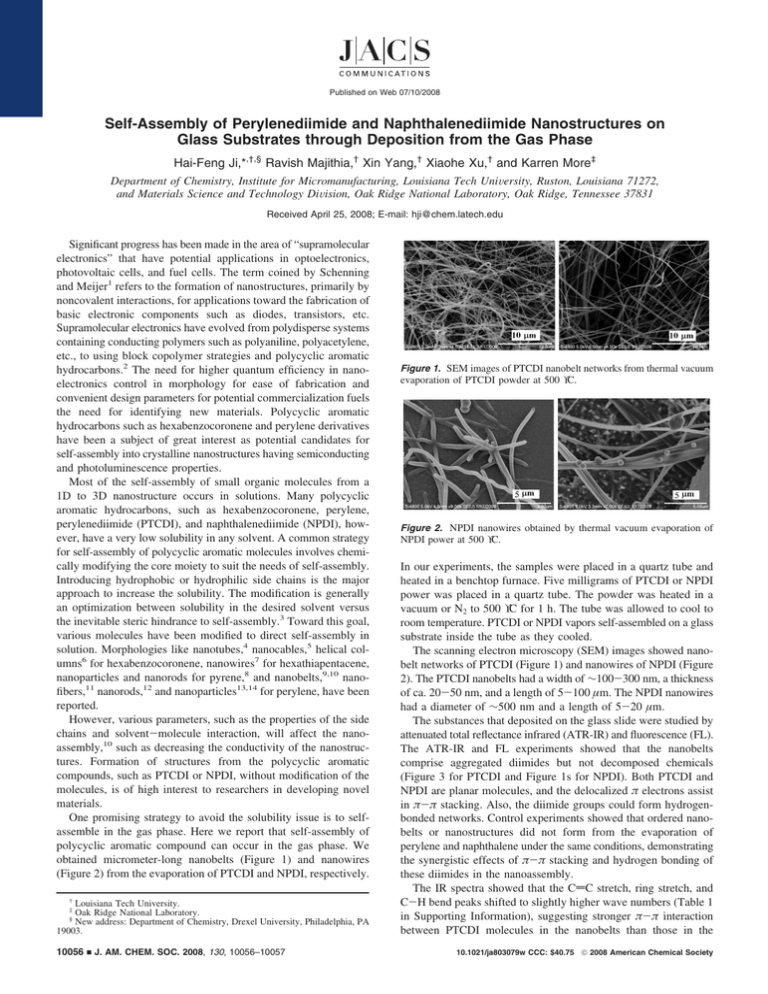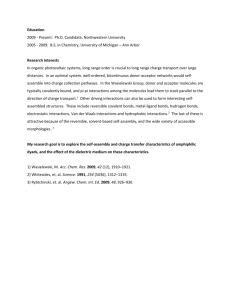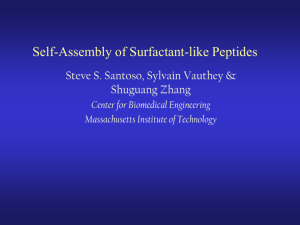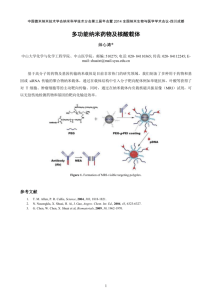Self-Assembly of Perylenediimide and Naphthalenediimide Nanostructures on
advertisement

Published on Web 07/10/2008 Self-Assembly of Perylenediimide and Naphthalenediimide Nanostructures on Glass Substrates through Deposition from the Gas Phase Hai-Feng Ji,*,†,§ Ravish Majithia,† Xin Yang,† Xiaohe Xu,† and Karren More‡ Department of Chemistry, Institute for Micromanufacturing, Louisiana Tech UniVersity, Ruston, Louisiana 71272, and Materials Science and Technology DiVision, Oak Ridge National Laboratory, Oak Ridge, Tennessee 37831 Received April 25, 2008; E-mail: hji@chem.latech.edu Significant progress has been made in the area of “supramolecular electronics” that have potential applications in optoelectronics, photovoltaic cells, and fuel cells. The term coined by Schenning and Meijer1 refers to the formation of nanostructures, primarily by noncovalent interactions, for applications toward the fabrication of basic electronic components such as diodes, transistors, etc. Supramolecular electronics have evolved from polydisperse systems containing conducting polymers such as polyaniline, polyacetylene, etc., to using block copolymer strategies and polycyclic aromatic hydrocarbons.2 The need for higher quantum efficiency in nanoelectronics control in morphology for ease of fabrication and convenient design parameters for potential commercialization fuels the need for identifying new materials. Polycyclic aromatic hydrocarbons such as hexabenzocoronene and perylene derivatives have been a subject of great interest as potential candidates for self-assembly into crystalline nanostructures having semiconducting and photoluminescence properties. Most of the self-assembly of small organic molecules from a 1D to 3D nanostructure occurs in solutions. Many polycyclic aromatic hydrocarbons, such as hexabenzocoronene, perylene, perylenediimide (PTCDI), and naphthalenediimide (NPDI), however, have a very low solubility in any solvent. A common strategy for self-assembly of polycyclic aromatic molecules involves chemically modifying the core moiety to suit the needs of self-assembly. Introducing hydrophobic or hydrophilic side chains is the major approach to increase the solubility. The modification is generally an optimization between solubility in the desired solvent versus the inevitable steric hindrance to self-assembly.3 Toward this goal, various molecules have been modified to direct self-assembly in solution. Morphologies like nanotubes,4 nanocables,5 helical columns6 for hexabenzocoronene, nanowires7 for hexathiapentacene, nanoparticles and nanorods for pyrene,8 and nanobelts,9,10 nanofibers,11 nanorods,12 and nanoparticles13,14 for perylene, have been reported. However, various parameters, such as the properties of the side chains and solvent-molecule interaction, will affect the nanoassembly,10 such as decreasing the conductivity of the nanostructures. Formation of structures from the polycyclic aromatic compounds, such as PTCDI or NPDI, without modification of the molecules, is of high interest to researchers in developing novel materials. One promising strategy to avoid the solubility issue is to selfassemble in the gas phase. Here we report that self-assembly of polycyclic aromatic compound can occur in the gas phase. We obtained micrometer-long nanobelts (Figure 1) and nanowires (Figure 2) from the evaporation of PTCDI and NPDI, respectively. † Louisiana Tech University. Oak Ridge National Laboratory. New address: Department of Chemistry, Drexel University, Philadelphia, PA 19003. ‡ § 10056 9 J. AM. CHEM. SOC. 2008, 130, 10056–10057 Figure 1. SEM images of PTCDI nanobelt networks from thermal vacuum evaporation of PTCDI powder at 500 °C. Figure 2. NPDI nanowires obtained by thermal vacuum evaporation of NPDI power at 500 °C. In our experiments, the samples were placed in a quartz tube and heated in a benchtop furnace. Five milligrams of PTCDI or NPDI power was placed in a quartz tube. The powder was heated in a vacuum or N2 to 500 °C for 1 h. The tube was allowed to cool to room temperature. PTCDI or NPDI vapors self-assembled on a glass substrate inside the tube as they cooled. The scanning electron microscopy (SEM) images showed nanobelt networks of PTCDI (Figure 1) and nanowires of NPDI (Figure 2). The PTCDI nanobelts had a width of ∼100-300 nm, a thickness of ca. 20-50 nm, and a length of 5-100 µm. The NPDI nanowires had a diameter of ∼500 nm and a length of 5-20 µm. The substances that deposited on the glass slide were studied by attenuated total reflectance infrared (ATR-IR) and fluorescence (FL). The ATR-IR and FL experiments showed that the nanobelts comprise aggregated diimides but not decomposed chemicals (Figure 3 for PTCDI and Figure 1s for NPDI). Both PTCDI and NPDI are planar molecules, and the delocalized π electrons assist in π-π stacking. Also, the diimide groups could form hydrogenbonded networks. Control experiments showed that ordered nanobelts or nanostructures did not form from the evaporation of perylene and naphthalene under the same conditions, demonstrating the synergistic effects of π-π stacking and hydrogen bonding of these diimides in the nanoassembly. The IR spectra showed that the CdC stretch, ring stretch, and C-H bend peaks shifted to slightly higher wave numbers (Table 1 in Supporting Information), suggesting stronger π-π interaction between PTCDI molecules in the nanobelts than those in the 10.1021/ja803079w CCC: $40.75 2008 American Chemical Society COMMUNICATIONS Figure 3. ATR-IR and FL spectra of nanobelts self-assembled in the gas phase and PTCDI powders. Figure 4. TEM images (left) and electron diffraction patterns (right) of PTCDI nanobelt. Scheme 1. Formation of Nanofibers of PTCDI through π-π Stacking and Hydrogen Bonding The nature of the substrate played a large role on the selfassembly of PTCDI and NPDI. The nanowire or nanobelt formation observed on the surface of glass and on the edges of Si was absent on the surfaces of a Si wafer, Au-coated Si, and quartz. On the other hand, PTCDI was reported to self-assemble into a monolayer film on Au substrates at somewhat lower temperatures.16 The deposition of the nanostructure on glass substrates may start with the hydrogen bonding between the Si-OH of the glass and PTCDI or NPDI. The role of the substrate on the self-assembly process requires further investigation. In summary, this work demonstrates the self-assembled nanostructures of PTCDI and NPDI by H-bonding and π-π stacking prepared in the gas phase. With the systems of PTCDI and NPDI as two cases demonstrated here, we propose a simple yet effective technique for self-assembly. This is a new strategy to assemble organic molecules to nanostructures, typically for those having very low solubility in solvents. This approach would completely eliminate the effect of side chains and will assist us in developing novel self-assembled nanostructures from aromatic organic molecules directly in the gas phase. The factors controlling the formation and morphology of the nanoassembly will be further studied in the future. Potential applications of these nanowires range from fabrication of building blocks in nanoelectronics, optoelectronics, to exploring the photoluminescence properties of aromatic compounds for light emitting devices. Particularly, the nanoassembly prepared from this method could be made in large quantities at a low cost since no further organic synthesis will be needed, which makes them competitive in preparing nanoelectronic-based devices. Acknowledgment. This work was supported by NSF Sensor and Sensor Network ECS-0428263. TEM research at the Oak Ridge National Laboratory SHaRE User Facility was sponsored by the Scientific User Facilities Division, Office of Basic Energy Sciences, U.S. Department of Energy powders. However, the CdO stretch peak did not change, indicating similar hydrogen bond behavior in the PTCDI nanobelt and the powders. The FL spectrum showed strong π-π stacking of the PTCDI molecules in both powders and nanobelts. Transmission electron microscopy (TEM) experiments indicated that the PTCDI nanobelts (Figure 4) have a crystalline structure, and the fibers exhibit diffuse “texture” in longitudinal direction. The corresponding electron diffraction pattern (Figure 4 right) shows well-defined diffraction spots with 14 Å characteristic d-spacing in the perpendicular direction and 3.6 Å d-spacing in the longitudinal nanobelt direction, which suggests that the molecules are oriented with their long axis perpendicular to the belt and the π-π stacking direction parallel to the belt, as shown in Scheme 1. The 3.6 Å π-π stacking space between two adjacent molecular planes is consistent with that of similar PTCDI molecules.15 The 14.02 Å distance between two H-bonded PTCDI was modeled by Chem3D. No crystalline structure of NPDI nanowires, however, was observed from the TEM images. (Figure 2s in Supporting Information). Experiments have been conducted at temperatures between 300 and 700 °C to study the effect of temperature on the morphology of the nanoassembly. Self-assembly occurred only when the temperature was higher than 500 °C. The morphologies of the nanostructures above 500 °C were similar. Experiments on pressure effect showed the morphology and length of the wires were independent of N2 pressure. Supporting Information Available: Experimental procedures and additional figures. This material is available free of charge via the Internet at http://pubs.acs.org. References (1) Green, J. E.; Choi, J. W.; Boukai, A.; Bunimovich, Y.; Johnston-Halperin, E.; Delonno, E.; Luo, Y.; Sheriff, B. A.; Xu, K.; Shin, Y. S.; Tseng, H.-R.; Stoddart, J. F.; Health, J. R. Nature 2007, 445, 414. (2) Schenning, A. P. H. J.; Meijer, E. W. Chem. Commun. 2005, 3245. (3) Meijer, E. W.; Schenning, A. P. H. J. Nature 2002, 419, 353. (4) Würthner, F. Chem. Commun. 2004, 1564. (5) Hill, J. P.; Jin, W.; Kosaka, A.; Fukushima, T.; Ichihara, H.; Shimomura, T.; Ito, K.; Hashizume, T.; Ishii, N.; Aida, T. Science 2004, 304, 1481. (6) Xiao, S.; Tang, J.; Beetz, T.; Guo, X.; Tremblay, N.; Siegrist, T.; Zhu, Y.; Steigerwald, M.; Nuckolls, C. J. Am. Chem. Soc. 2006, 128, 10700. (7) Dehm, V.; Chen, Z.; Baumeister, U.; Prins, P.; Siebbeles, L. D. A.; Würthner, F. Org. Lett. 2007, 9, 1085. (8) Briseno, A. L.; Mannsfeld, S. C. B.; Lu, X.; Xiong, Y.; Jenekhe, S. A.; Bao, Z.; Xia, Y. Nano Lett. 2007, 7, 668–675. (9) Zhang, X.; Zhang, X.; Shi, W.; Meng, X.; Lee, C.; Lee, S. J. Phys. Chem. B 2005, 109, 18777. (10) Balakrishnan, K.; Datar, A.; Oitker, R.; Chen, H.; Zuo, J.; Zang, L. J. Am. Chem. Soc. 2005, 127, 10496. (11) Balakrishnan, K.; Datar, A.; Naddo, T.; Huang, J.; Oitker, R.; Yen, M.; Zhao, J.; Zang, L. J. Am. Chem. Soc. 2006, 128, 7390. (12) Yan, P.; Chowdhury, A.; Holman, M. W.; and Adams, D. M. J. Phys. Chem. B 2005, 109, 724. (13) Liu, Y.; Li, Y.; Jiang, L.; Gan, H.; Liu, H.; Li, Y.; Zhuang, J.; Lu, F.; Zhu, D. J. Org. Chem. 2004, 69, 9049. (14) Jancy, B.; Asha, S. K. Chem. Mater. 2008, 20, 169. (15) Zhang, X.; Sun, B. J. Phys. Chem. B 2007, 111, 10881. (16) Caǒas-Ventura, M. E.; Xiao, W.; Wasserfallen, D.; Mùllen, K.; Brune, H.; Barth, J. V.; Fasel, R. Angew. Chem., Int. Ed. 2007, 46, 1814. JA803079W J. AM. CHEM. SOC. 9 VOL. 130, NO. 31, 2008 10057





